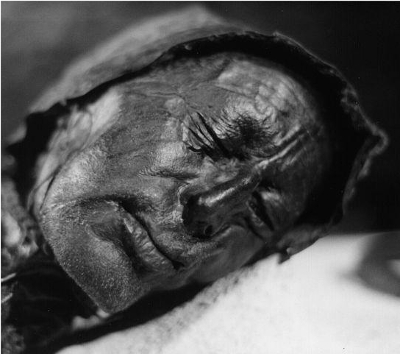Natural mummification is the process by which the skin and organs of a deceased person or animal are preserved, without the introduction of chemicals by humans. Natural mummification is typically caused by extreme cold, arid conditions, or lack of oxygen. Naturally preserved mummies have been found deposited in deserts, buried in oxygen-poor peat bogs, and frozen in glaciers.
Dry environments have desiccated and preserved human remains around the globe. For example, the hot sands of China’s Taklimakan Desert mummified the remains of people interred there 3,000 years ago. Archaeologists also found a set of partially-mummified remains buried in Spirit Cave near Fallon, Nevada, in 1940. The remains are more than 9,400 years old.
The Chinchorro people who lived near Chile’s Atacama Desert likely noticed this effect, and began to take advantage of it 7,000-8,000 years ago. The Chinchorro mummified bodies by removing the muscles and inserting sticks and clay or vegetation. They covered the faces with clay masks, and often painted the bodies.

The environmental conditions of peat bogs, which are common throughout the British Isles, are also conducive to natural mummification. Archaeologists have found the remains of several ancient people in bogs in the United Kingdom, Ireland, and other northern European countries. These individuals may have been killed and deposited in the bogs as human sacrifices. Acidity, oxygen deprivation, and low temperatures effectively tanned the soft tissues.
Ice has preserved the bodies of Inca-period individuals from the mountainous regions of Argentina, Chile, and Peru. The “ice mummy” of El Plomo is a male child discovered on Plomo Peak in Chile in 1954. Mummy Juanita was discovered in the Peruvian Andes. Archaeologists believe she was a human sacrifice who was left to die from exposure. In 1999, three additional mummies were found along the border of Argentina and Peru. The two girls and one boy may have been sacrificed as part of an ancient ritual. Their remains are referred to as the “Llullaillaco mummies.”
Ötzi the Iceman is the oldest known natural human mummy. He was discovered frozen in an Alpine glacier in 1991. After the man was killed by an arrow 5,300 years ago, he was quickly covered by snow and ice, which preserved his remains, clothing, and tools. His 61 tattoos are still clearly visible.